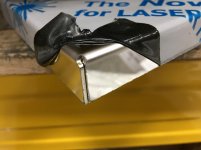First question would be: Ignoring the corners, are the outside dimensions of the parts coming out correct? If so, your corner notches are cut wrong. If not, skip the next couple paragraphs.
I don't use solidworks, so I'm unfamiliar with anything pertaining to it, but it's very easy to look at the parts and see what is wrong - hopefully you're familiar enough with the program to be able to communicate the needed changes to it.
I'm going to assume your dimensions are correct, given that you've asked about closing up the gap, as opposed to asking about how to fix the finished part dimensions.
Looking at picture one, as well as the picture with the white painted sheet, it's clear that the parts are notched back too far - that's not something that could be hammered or clamped back. You need to measure whatever gap you have, and decrease that amount from the notch cutout size (ie, if in one direction, you measure a 1/8" gap, you need the notch to be 1/8" smaller than it currently is).
What's usually a good rule of thumb for me for notch size is the outside height of the flange, minus the material thickness (3" flange on 11 gauge material would use a 2 7/8" notch).
There also seems to be angular issues. Those are probably only 1-2 degrees off, but on a flange that large on material that thin, a degree or two is significant. I can't even imagine trying to work with +/- 5 degrees.

That's not something we can help with, you or whoever is bending those will have to clean that up at the machine.
On the parts with the return bend in one direction, and merely a single flange on the other, bend the single flanges first, then turn the part to hit the bends with the return flange. If you bend the return sides first, the single sides will collide with them when overbending to compensate for springback. If you do the return flanges last, the flange can overbend into the space between the single flanges, then spring back to the proper angle. Furthermore, this saves you from having to use horn tooling to get into the corners.
If it turns out that the part dimensions are wrong, it likely has to do with solidworks not having the right radius listed. You'll need to do as rcoope mentioned, and measure the radius that whatever tooling you are using gives you on each material thickness you use, and work with that. My understanding is that solidworks is capable of doing the K-factor calcs (and that will probably fix the gaps, and place the clearance hole correctly), but if not, the formulas are readily available online to calculate your unfolded blank size, and then you can easily figure the notch cuts using the method I mentioned above.










 That's not something we can help with, you or whoever is bending those will have to clean that up at the machine.
That's not something we can help with, you or whoever is bending those will have to clean that up at the machine.
